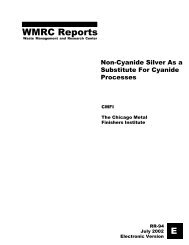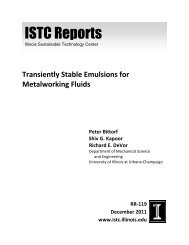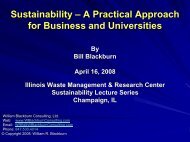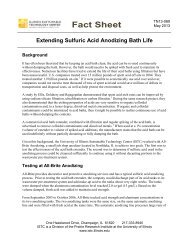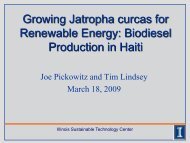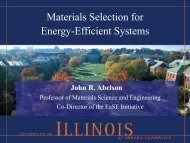Natural Resource Damage Assessment: Methods and Cases
Natural Resource Damage Assessment: Methods and Cases
Natural Resource Damage Assessment: Methods and Cases
You also want an ePaper? Increase the reach of your titles
YUMPU automatically turns print PDFs into web optimized ePapers that Google loves.
discharge on receptors studied in the ecological risk assessment. In the case of groundwater,<br />
however, an ecological risk assessment is not required.<br />
The Department developed a method for determining the injuries to groundwater that is<br />
inexpensive <strong>and</strong> less time consuming than the methods applied to other resources. This method is<br />
applied to all groundwater that is classified as Class II pursuant to the State’s Groundwater<br />
Quality St<strong>and</strong>ards. The simplified method utilizes only information that is already available or<br />
that must be collected as part of the remediation process by following the technical regulations<br />
for site remediation. This chapter describes <strong>and</strong> analyzes the method as it existed at the time of<br />
our survey. Unlike the simplified methods used by Washington <strong>and</strong> Florida, New Jersey’s<br />
simplified NRDA method is not codified by state legislation <strong>and</strong> thus is subject to change.<br />
Several changes have been made to the method since then. Some of those changes will be<br />
mentioned in the following discussion; however, for an updated description of the simplified<br />
method used by New Jersey, see the website of the state’s ONRR (Currently<br />
http://www.nj.gov/dep/nrr/nri/nri_gw.htm.)<br />
The basic steps in New Jersey’s 1999 simplified assessment process are as follows; note<br />
that steps four <strong>and</strong> five have been dropped in recent modifications:<br />
(1) Characterize extent of groundwater contamination.<br />
(2) Identify remedial action for groundwater contamination.<br />
(3) Determine duration of natural resource injury.<br />
(4) Determine applicability of onsite exemption.<br />
(5) Determine applicability of de minimis exemptions.<br />
(6) Determine which water supply planning area the contaminant plume is located in <strong>and</strong><br />
the projected status (e.g. surplus, deficit) of that area in the year 2040.<br />
(7) Determine annual groundwater recharge rate.<br />
(8) Determine dollar value of potable water.<br />
(9) Calculate surrogate value of the groundwater injury.<br />
The first three steps are based on information obtained as part of the remedial<br />
investigation of the groundwater for the site as required by the Technical Requirements for Site<br />
Remediation. The most typical nondepletive remedial actions used for contaminated groundwater<br />
are, pump <strong>and</strong> treat systems that reinject the treated groundwater either on-site or off-site, natural<br />
attenuation, <strong>and</strong> in situ treatment. The duration of injury is defined as time in years between<br />
when the remedial decision is made <strong>and</strong> when the water meets New Jersey groundwater quality<br />
st<strong>and</strong>ards or 30 years, whichever is smaller.<br />
There were a variety of limits on assessed damages under this approach which seem to<br />
have been eliminated by recent changes to the policy. The Department did not require restoration<br />
of natural resource injuries to groundwater if the contaminated plume has not traveled beyond<br />
the current boundaries of the property where the discharge occurred, the remedial action is a nondepletive<br />
action, <strong>and</strong> no other natural resources (such as wetl<strong>and</strong>s or surface waters) are affected<br />
by the contaminated groundwater. Even if the contaminant plume has moved off-site, the<br />
department specified de minimis criteria on the size <strong>and</strong> duration of the plume for which it would<br />
not require restoration of natural resource injuries to groundwater. Additionally, it was specified<br />
43



